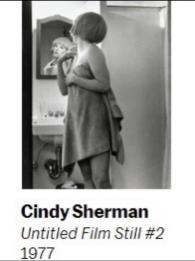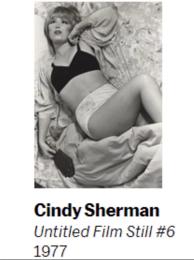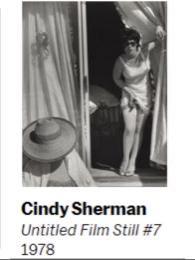1. Introduction
In the 20th century, A group of excellent female photographers have combined documentary, makeup, performance and behavior to construct a unique, novel image world in the context of women, and have expanded the artistic expression of selfie photography from a multidimensional perspective. Cindy Sherman is one of them; in particular, her “Untitled Film Stills” has left a profound influence on the world photography art. In the stills, Sherman imitates the dress, postures, expressions, makeup of some movie characters or fashion models, which leads the audience to realize that the limitation and shaping of the female image have always been derived from the needs and standards of men. Cindy Sherman’s silent performance which is an expression of feminine body writing aims to satirize the patriarchal society’s disregard and solidification of women’s own values. Feminine body writing was first proposed by Hélène Cixous in her theory, “The Laugh of the Medusa”. From Cixous’s standpoint, the ultimate goal of feminine writing is to destroy the estrangement, hierarchy and rules of the patriarchal society through the sensitivity and variation of female bodies, so as to create a new kind of rebellious writing.
There are relatively little research on American photographer, Cindy Sherman in China. Ruiqi Liu, a writer from Taiwan, China, expounds on the feminist characteristics by analyzing the works of Cindy Sherman in different periods in “Negative Video: A Female Photographer’s Dress-up Selfie Portrait”. “Cindy Sherman” written by Gongbo Zhao, gives a general introduction to the creation of the artist, and collects relevant essays, interviews and notes. Compared with in China, there are many research works on Cindy Sherman at abroad. The most comprehensive study is “Cindy Sherman: 1975-1993” by Rosalind Krauss. Laura Mulvey, a British writer, analyzes Sherman’s works in “Fetishism and Curiosity” from the perspective of female image and male gaze. In addition, there are numerous journal papers concerning the research of Cindy Sherman. The literature mentioned above provides plenty of information for this study, so that this paper is able to have a more comprehensive understanding of Sherman's life and works, and get more enlightenment in the following research. However, there is a scarcity of academic research to analyze Cindy Sherman’s photographs from the perspective of feminine body writing.
Therefore, this paper will apply Cixous’s theory of feminine body writing to argue what Cindy Sherman’s “Untitled Film Stills” suggest about feminism. This paper is divided into three chapters. The first chapter will analyze the sample pictures from the perspective of dressing and postures to verify whether women are enslaved to the male gaze or not. The second chapter will examine the way of female expression through observing facial expressions and makeup of the model in the selected photos. Furthermore, the third chapter will investigate Cixous’s claim “flying in language and making it fly”[] by a discussion on scenes and identities in Sherman’s photos. Besides, this study will try to conclude the internal values and significance of Sherman’s artwork for the development of postmodernist feminism.
2. Women Enslaved to the Male Gaze
As the male gaze is increasingly powerful, which can slander women’s behavior maliciously and enslave women’s mind randomly. In this way, the body becomes the tool of confining women. In “The Laugh of the Medusa”, Hélène Cixous mentions that “By writing her self, woman will return to the body which has been more than confiscated from her, which has been turned into the uncanny stranger on display--the ailing or dead figure, which so often turns out to be the nasty companion, the cause and location of inhibition”[]. It means that under the rule of a patriarchal society, women’s bodies are often vilified and imprisoned by social prejudice. Cixous also believes that the male-centered culture has instilled in women on the issue of sexuality that are not needed by women themselves, such as the desire for male organs, the desire for fertility, maternal glory and so on. In fact, these ideas are men’s consciousness and men aim to change women’s mind and body for their own needs. Accordingly, the body is changed into a cage for women, while the male gaze is the reason for the formation of the body cage. Because of the loss of body freedom, women have lost their voice, that is, they do not have an opportunity to say what they want and show how they feel. It is worse that women have to obey the rules set by men and change themselves to satisfy men’s demands, which means that the social status of women is interior to that of men and the female image is shaped by men. Here are some sample pictures chosen from “Untitled Film Stills”:
|
|
|
| |||
Figure 1: Untitled Film Still #2. | Figure 2: Untitled Film Still #6. | Figure 3: Untitled Film Still #7. | Figure 4: Untitled Film Still #15. |
The female characters in these three photos are all played by Sherman. In Untitled Film Still #2, the model just wraps her body in a bath towel and looks herself in the mirror. Sherman only wears a black bra and a white pantie lying on the bed in Untitled Film Still #6 . In Untitled Film Still #7, she wears a prominent bra and a skintight slip dress, and pulls up one side of the dress exposing her thighs. Untitled Film Still #15 shows that Sherman is in a low-cut and high-waist dress and a pair of high-heel shoes sitting on the windowsill; and she raises one of her legs.
In the patriarchal society, female images are shaped by men and women should show their beauty and charm as men’s standard and request. For example, women will be praised for their curves, so women should wear prominent bras, high-waist dress and do some sexy poses despite those may make them feel uncomfortable. As Simone de Beauvoir claims, “Clothing is so important to many women because it allows women to recreate the outside world and their inner selves simultaneously through hallucinations”[]. The dressing and postures of the models in these four photos all contain a little sexual suggestiveness. The characters in the photos are both like sexy girls in fashion magazines and actresses hiding in their private space in movie scenes. They all wear skimpy clothes and pose sexy. Moreover, among these photos, the woman is lying, standing or sitting in her private space, which makes the audience peeking at the woman like a voyeur. Sherman tries to imply the hidden presence of men among these pictures through putting the audience in a perspective of peeking, and skimpy clothes and sexy postures are also hints for the male gaze.
The exposure of the male gaze is used to reveal the dilemma of women and to criticize the patriarchy. Beauvoir has stated that “One is not born a woman, but rather becomes one”[]. It means that under the male gaze, women’s body is gradually becoming their own cage, which not only limits their behavior but also confines their mind. Due to that, women lose their liberty and tend to obey men’s order blindly. Through these photographs, Sherman points out that male gaze enslaves women and shapes female images by restricting or controlling women’s body. The body does not belong to women themselves any more but turns into a cage for them. Showing the dilemma of women, Sherman achieves her goal to utilize the female characters on each photo to expose the male gaze and criticize the patriarchal society.
3. Female Body as a Special Expression
Although the body is a cage for women, women express their ideas through their body unconsciously. It means that the interaction between the model and the audience is bidirectional; the audience can observe the male gaze hidden behind the photos and the female model can also show something through their facial expressions, makeup and postures. Losing the liberty of body means losing the right to write as well as the right to speak. When women want to say something, they find that they use male language. In order to break this situation, the female body is the only medium that can be used for self-expression. According to that, Cixous asserts in her theory that “Her flesh speaks true. She lays herself bare. In fact, she physically materializes what she's thinking; she signifies it with her body”[]. Though the body limits women’s behavior, the limitations on their mind and body materialize through the facial looks and postures and Cixous encourages women to use this method to break the dilemma. The body here is not only a physiological body, but represents the transcendence of the opposition between body and mind, that is, the body with soul. The female body starts to have the meaning of survival ontology, and starts to reach the unity of spirits and flesh. Sherman’s photographs is a good example that put Cixous’s theory into practice. Here are some examples selected from “Untitled Film Stills”:
|
|
|
| |||
Figure 5: Untitled Film Still #12. | Figure 6: Untitled Film Still #27. | Figure 7: Untitled Film Still #29. | Figure 8: Untitled Film Still #30. |
In Untitled Film Stills #12, the female character in a floral dress is leaning on the wall and her facial expression is panic and afraid, as if someone is threatening her or is going to beat her. Look at Untitled Film Still #27, the model’s makeup is smudged and her face is tear-stained, which suggests that she has just cried seriously. Untitled Film Still #29 demonstrates that the woman has cried a lot because tears have also smudged her makeup; and the female character puts her right hand out as if she wants to catch something. There is no denying that she lives a miserable life and may be a victim to domestic abuse. In Untitled Film Still #30, the model is staring at the camera with scare; and her mouth is slightly open, as if she wants to say something but she cannot. Also, her eye makeup is smudged a lot, and there are bruises on her face which implies the woman has been beaten by somebody. The photos are still, and female body is enslaved to the male gaze, but the fearful facial expression and smudged makeup convey a fact to the audience that the woman in the picture is in abuse. From this, it is obvious that “dressing up is not just grooming, but also shows a woman’s social situation”[]. In this special way, Sherman hints that women in the society subject to men and have difficulty in fighting against men by themselves. This is because the body of the women confines them as a cage, women do not have their own rights and liberty to say what they want or do what they like; but their limited body is another expression, which embodies the current dilemma of women through women’s painful looks and stiff motions.
Women cannot express their ideas from the bottom of the heart, but Sherman uses the image language to speak out for them. Sherman simulates various kinds of women in the real life and incorporates true feelings of those women into the performance. She reveals the real situation of women in front of the camera boldly in order to make people recognize the plight of women and awake women’s self-consciousness, which is a special form of feminine body writing. Therefore, the image language which is made up of the model’s facial expression, makeup and so on is undoubtedly true, because what Sherman plays and performs are all based on the real life of women. According to that, the audience are able to get some ideas of women when seeing these pictures; in other words, it is Sherman that supplied an opportunity to women to voice for themselves and to be the champions for themselves.
Besides, Sherman chose self-snapshot as her creative way and used photography and image language to express artistic ideas. The reason why she chose self-snapshot is that selfie photography was a powerful weapon for female photographers to pay attention to themselves, emphasize their own values and fight against the patriarchal society. Nonetheless, it should be noted that selfie photography does not show the photographer's own image, but conveys the desire to express ideas and reflect social problems, or a dilemma of a social group. Female photographers explore the nature of women and the situation of women through photography, a pure and meaningful ritual. Hence, selfie photography is a special kind of body writing as well as a way that belongs to women and is free from external influence and bondage.
4. Women Should Promote Feminine Body Writing
Feminist works will usually reveal women’s trouble or some unequal social phenomena and then show women’s struggle for their rights, which will lead the females in trap to wake up and change their situation. In “The Second Sex”, Beauvoir indicates that “People shut up a woman in the kitchen or boudoir and marvel at her limited vision; people break her wings and lament that she can't fly. If only people would open up her future, she would never be forced to stay in the present again”[]. And then in “The Laugh of the Medusa”, Cixous holds an opinion that “Flying is woman’s gesture--flying in language and making it fly……for centuries we’ve been able to possess anything only by flying”[]. “Flying in language and making it fly” is Cixous’s dream goal, which means that women should take full advantage of body writing to speak out, to break the male-centred culture, to create their own language; and then women should also promote feminine language and guard the rights to speak and write freely. These two feminists both stress the concept of “fly” which is a symbol of women’s struggle against patriarchal world, so “fly” is of great significance in the analysis of feminism.
However, Cindy Sherman has ever said that she is not a feminist, her photography works indicate feminine consciousness unconsciously. During the period of her creation, “feminism”, “feminine body writing” and “male gaze” have not been popular yet, however Sherman has gone beyond the level of feminism itself by means of her mutual image language, and constantly expand the possibility of self-discovery. She alone served as various identities, director, lighting engineer, stylist, actress, photographer, etc.; at the same time, she also played many roles in her works, performed a variety of different identities of women, and feel the life of women in the real society. Here are some instances chosen from “Untitled Film Stills”:
|
|
| ||
Figure 9: Untitled Film Still #9. | Figure 10: Untitled Film Still #10. | Figure 11: Untitled Film Still #13. | ||
|
|
| ||
Figure 12: Untitled Film Still #16. | Figure 13: Untitled Film Still #20. | Figure 14: Untitled Film Still #45. |
In Untitled Film Still #9, Sherman who is in a bikini plays a star who is on a holiday by the sea. This scene is taken in a sparsely populated place due to the special identity of celebrity. In Untitled Film Still #10, the woman seems to be a housewife cleaning the room. She is half squatting in the kitchen with tools in her hand, and there are a pile of household utensils at her feet, and behind her was a cupboard. The woman looks to be surrounded by chores; from her face, it is easy to see her exhaustion and unwilling. Sherman dresses in a uniform to turn herself into a librarian in Untitled Film Still #13; and she is looking up at the ceiling near the bookshelf in the library. In Untitled Film Still #15, the character is a professional woman who seems different from the previous ones; and she is sitting in her office with a cigarette in her hand, just like a business executive. In Untitled Film Still #20, Sherman wears a turban, a bow-tied shirt and a skirt in order to play a maid just about to come home from work outside a mansion. She looks hurried but with a gentle expression, showing the kind and docile character of the maid. Untitled Film Still #45 displays that the woman is swimming in a swimsuit; from this, the audience can guess maybe she is a swimming athlete or a keen swimmer.
Although these female characters are in different scenes and have different identities, they all have a common point--they do not face the camera directly. They all seem to avoid the camera simultaneously, and their expressions are as uneasy as if they are being peeped by somebody. Sherman implies through this setting to the audience that women are generally under the male gaze. For example, housewives are bound by tedious housework and lose their freedom, while professional women will become sensitive and disturbed by harassment in the workplace. Whatever their occupations are, women have all kinds of suffering and fail to escape the male gaze and the rule of patriarchy. Judging from that, women with various kinds of identities are the same, all suffer from common trouble. Tara Westover points out that “It’s not the clothing that makes this face, this woman special; it’s what’s behind the eyes, what she’s biting between her teeth—hope, faith, or belief--that makes life not set in stone”[]. Without hope, faith, or belief, the women in trouble will never have power to save themselves, to struggle against patriarchal society, to set the new language for female world. As a consequence, it is a pity that Sherman’s photographs “Untitled Film Stills” did not let the audience see the sign of women breaking through the male gaze or endeavoring to get their own rights back. Facing the male gaze, the female characters in “Untitled Film Stills” choose to escape or accept it blindly rather than to break it or struggle for their own rights.
Sherman once commented on her own work, saying that she wanted to imitate something outside of the culture, and when she did so, she was also ridiculing the culture. Sherman said that she did it just for fun, but it mocked the patriarchal logic behind the photos. The goal of Sherman incorporating body writing into photography may have two explanations. She may just want to record the reality in the society and express the irony and dissatisfaction with the patriarchal society. The other thought is that maybe she hopes the audience to find the emotions and thoughts in her works, to think about the solidification of female image and the ugliness of female body, so as to stimulate the rebellion to the patriarchy, promote the awakening of female self-consciousness, and improve the breakthrough and revolution of the traditional taboos and stereotypes. Whatever Cindy Sherman’s object is, it is definite that her photographic work appeals to women for the promotion of feminine body writing. The feminist and historian, Joan Scott, has ever put forward that the language of human beings not only represents the world, but establish the history and the fact of people. Thus, the theory of Hélène Cixous “not only defends the image of Medusa, but also break the classical patriarchal writing and bring female autonomy back”[]. So is Sherman’s “Untitled Film Stills”. Because of the fact that the present society is under the rule of patriarchy, women should promote feminine body writing as soon as possible.
5. Conclusion
This paper has argued that Cindy Sherman’s “Untitled Film Stills” uses feminine body writing proposed by Hélène Cixous to reveal the dilemma of women, the special expression of female body, and the lack of women’s struggle. Cindy Sherman has built a bridge between feminine body writing and photography, which achieves to awake feminine consciousness and improve the development of feminism.
Through analyzing photos from the perspective of dressing and postures, the first investigation of women who are enslaved to the male gaze has shown that women’s rights and freedom have been deprived and their own body has been turned into a cage by the male gaze. Then, examining the models’ facial expressions and makeup, the second major finding is that female body is limited, but it is a special expression of women, which uncover the fear, abuse, and suffering that women live in. Moreover, the third section is a shortcoming of Sherman’s feminine writing, but it still shows her awakening bud of feminism by displaying women of different identities in different scenes. In short, the relevance of feminism in Sherman’s pictures is clearly supported by the current findings.
These findings have significant implications for the understanding of what Sherman wants to suggest in “Untitled Film Stills” through feminine body writing. Sherman’s work discloses the sexual discrimination and the male gaze hidden in social life; and it encourages more people to realize women’s situation and show more care to the females. Sherman not only promotes the development of western postmodernist feminism, but also provides a great deal of enlightenment for feminists all over the world, and also gives feminine body writing a good demonstration in the field of photography. Nonetheless, the major limitation of this research is that these insights are only based on one series of Sherman’s works; maybe more text analysis will bring more reasonable and thoughtful insights. Besides, being limited to the angle of feminine body writing, this study lacks other perspectives of feminism. Considerably more work will need to be done to explore more implications with regard to Cindy Sherman’s feminist expression.
References
[1]. Hélène Cixous, Keith Cohen and Paula Cohen. (1976) The Laugh of the Medusa. Signs, Volume 1, No.4, 875-893. Retrieved from https://www.jstor.org/stable/3173239
[2]. Ruiqi Liu. (2004)Negative development: the female photographer dress up selfie like. Far Current Press, Taibei.
[3]. Gongbo Zhao. (2010)Cindy Sherman. Jilin Fine Arts Publishing House, Changchun.
[4]. Rosalind Krauss. (1993) Cindy Sherman 1975-1993. Rizzoli, New York.
[5]. Laura Mulvey. (1996) Fetishism and Curiosity. Indiana University Press, Bloomington.
[6]. Simone De Beauvoir. (2011) The Second Sex. Knopf Publish Group, New York.
[7]. Tara Westover. (2018) Educated: A Memoir. Random House US, New York.
[8]. Zaiko, Vanda, Miriam Leonard. (2012) Laughing with Medusa: Classical Myth and Feminist Thought. Oxford University Press, 1-20.
[9]. Paul Moorhouse. (2014) Cindy Sherman. Phaidon, London.
[10]. Georgina Colby. (2012) Radical Interiors: Cindy Sherman's ‘Sex Pictures’ and Kathy Acker’s My Mother: Demonology. Women: A Cultural Review, Volume 23, Issue 2, 182-200.
[11]. Ackerman J. Luca, et al. (2016) Cindy Sherman: A Play of Selves. A collaborative approach to conservation. Studies in Conservation, Volume 61, Issue sup2, 1-6.
[12]. Pamela Church Gibson. (2018) Cindy Sherman in a New Millennium: Fashion, Feminism, Art and Ageing. Australian Feminist Studies, Volume 33, Issue 98, 481-497.
[13]. Cindy Sherman | MoMa. Retrieved from https://www.moma.org/artists/5392.
Cite this article
Lin,X. (2023). Feminine Body Writing in “Untitled Film Stills”. Lecture Notes in Education Psychology and Public Media,3,516-522.
Data availability
The datasets used and/or analyzed during the current study will be available from the authors upon reasonable request.
Disclaimer/Publisher's Note
The statements, opinions and data contained in all publications are solely those of the individual author(s) and contributor(s) and not of EWA Publishing and/or the editor(s). EWA Publishing and/or the editor(s) disclaim responsibility for any injury to people or property resulting from any ideas, methods, instructions or products referred to in the content.
About volume
Volume title: Proceedings of the 3rd International Conference on Educational Innovation and Philosophical Inquiries (ICEIPI 2022), Part II
© 2024 by the author(s). Licensee EWA Publishing, Oxford, UK. This article is an open access article distributed under the terms and
conditions of the Creative Commons Attribution (CC BY) license. Authors who
publish this series agree to the following terms:
1. Authors retain copyright and grant the series right of first publication with the work simultaneously licensed under a Creative Commons
Attribution License that allows others to share the work with an acknowledgment of the work's authorship and initial publication in this
series.
2. Authors are able to enter into separate, additional contractual arrangements for the non-exclusive distribution of the series's published
version of the work (e.g., post it to an institutional repository or publish it in a book), with an acknowledgment of its initial
publication in this series.
3. Authors are permitted and encouraged to post their work online (e.g., in institutional repositories or on their website) prior to and
during the submission process, as it can lead to productive exchanges, as well as earlier and greater citation of published work (See
Open access policy for details).
References
[1]. Hélène Cixous, Keith Cohen and Paula Cohen. (1976) The Laugh of the Medusa. Signs, Volume 1, No.4, 875-893. Retrieved from https://www.jstor.org/stable/3173239
[2]. Ruiqi Liu. (2004)Negative development: the female photographer dress up selfie like. Far Current Press, Taibei.
[3]. Gongbo Zhao. (2010)Cindy Sherman. Jilin Fine Arts Publishing House, Changchun.
[4]. Rosalind Krauss. (1993) Cindy Sherman 1975-1993. Rizzoli, New York.
[5]. Laura Mulvey. (1996) Fetishism and Curiosity. Indiana University Press, Bloomington.
[6]. Simone De Beauvoir. (2011) The Second Sex. Knopf Publish Group, New York.
[7]. Tara Westover. (2018) Educated: A Memoir. Random House US, New York.
[8]. Zaiko, Vanda, Miriam Leonard. (2012) Laughing with Medusa: Classical Myth and Feminist Thought. Oxford University Press, 1-20.
[9]. Paul Moorhouse. (2014) Cindy Sherman. Phaidon, London.
[10]. Georgina Colby. (2012) Radical Interiors: Cindy Sherman's ‘Sex Pictures’ and Kathy Acker’s My Mother: Demonology. Women: A Cultural Review, Volume 23, Issue 2, 182-200.
[11]. Ackerman J. Luca, et al. (2016) Cindy Sherman: A Play of Selves. A collaborative approach to conservation. Studies in Conservation, Volume 61, Issue sup2, 1-6.
[12]. Pamela Church Gibson. (2018) Cindy Sherman in a New Millennium: Fashion, Feminism, Art and Ageing. Australian Feminist Studies, Volume 33, Issue 98, 481-497.
[13]. Cindy Sherman | MoMa. Retrieved from https://www.moma.org/artists/5392.























